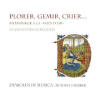Texte paru dans: / Appeared in:

Fanfare Magazine: 36:3 (01-02/2013)
Pour
s'abonner / Subscription information
Les abonnés à Fanfare Magazine ont accès aux archives du
magazine sur internet.
Subscribers to Fanfare Magazine have access to the archives of the magazine
on the net.
Aeon
AECD1226

3760058360262 (ID270)
Consultez toutes les évaluations recensées pour ce cd
~~~~ Reach all the evaluations located for this CD
Guillaume Crétin’s reputation survives primarily today on the basis of only one of his poems, the Lament on the Death of the Late Ockeghem, Treasurer of St. Martin of Tours. In it, he follows a much older tradition of couching his narrative in the form of a supposed dream. In it the great composers of the past—among which Crétin includes Dufay, Busnois, Dunstaple, Binchois, Lannoy, Pasquin, and others—assembled to welcome Ockeghem to their ranks with a performance of the Missa Mi-mi. Then he exhorts composers still living to weep musically for their dead comrade. Here, too, he isn’t hesitant in naming names, all of them well known then, several of them restored now to at least a measure of their old reputations: Josquin, Agricola, Brumel, and Compère are just a few. Whether it was Crétin’s work, or another, contemporaneous lament, Nymphes des bois by Jehan Molinet, or simply a high regard for the talents of the man who was considered among the foremost musicians of his time by many of his Franco-Flemish contemporaries, several of Ockeghem’s contemporaries gave musical vent to sorrow.
And that’s the theme of this disc. Molinet mentions Pierre de la Rue, and it’s the latter’s polytextural motet, Plorer, gemir, crier et braire, set against the Requiem eternam that leads off the program. (The juxtaposition of sudden harmonic shifts, swiftly moving sequences, and deliberately spare textures creates a paradoxical effect, mixing lightness and grief.) Similarly, Josquin provides a polytextural motet, one that sets Molinet’s lament, again against the Requiem’s theme. Lupus’s less adventurous but well-constructed work utilizes for its text an elegiac lament upon Ockeghem’s death written by Erasmus; the literary and philosophical giant also studied music with Obrecht. (Erasmus is curiously ambivalent in his writings on a number of musical matters, and states in “The Education of a Christian Prince” that children should only be allowed to hear and be instructed in music of high quality, since ingrained expectations are very hard to break.)
The last two works on this album aren’t laments, but tributes to the living. Obrecht himself contributed a mass that was originally thought to follow upon Ockeghem’s death in 1497, but a stylistic analysis by Rob Wegman (in his “Born for the Muses: the Life and Masses of Jacob Obrecht”) places it earlier—given the use of a plainchant associated with the Nativity of the Blessed Virgin on September 8, possibly a celebration of that day in 1484, during Obrecht’s brief service at the Cathedral of Cambrai. It is recognizably of an older generation than the motets of la Rue and Josquin, less concerned with expressive effect as we perceive it than with a remarkable display of contrapuntal craft, and the integration of various Ockeghem quotes. Finally, there’s the mercurial Busnois, who rose to the post of subdeacon at the Church of St. Martin in Tours, where Ockeghem was treasurer at the time. It’s worth considering that the second part to his extravagant In hydraulis begins with a motif (on the words, “Haec Ockeghem”) that is almost exactly mirrored in the superius of an Ockeghem motet, Ut heremita solus. As we don’t have dates for either work, whoever wrote his motet last presumably meant it as a compliment to the other.
Diabolus in Musica has been reviewed in these pages often enough by J.F. Weber to require no introduction. The ensemble here consists of 10 musicians: two female mezzos, two male altos, four tenors, and two basses. Most selections require far less, such as the four singers deployed in the la Rue, Lupus, and Busnois; and that’s especially appreciated in the last of the three pieces, where it contributes to a degree of clarity that works hand in glove with the composer’s contrapuntal and rhythmic cleverness. The Obrecht Mass is only the second recording of the work, and utilizes eight male voices—the same lineup as János Bali and the A.N.S. Choir employ (Hungaroton 32192). Weber liked that earlier performance (Fanfare 27:6), but I prefer this one both because the engineering is less reverberant, making for clearer lines, and because Diabolus in Musica’s director, Antoine Guerber, is less inclined to draw back and lengthen notes. I understand Bali’s desire to do so. All intellectual brilliance to one side, the Missa Sicut rosa spinam is a work of extraordinary lyricism; but this version moves it along at what I perceive as a better pace.
With full texts in Latin, French, and English, strongly recommended.
Cliquez l'un ou l'autre
bouton pour découvrir bien d'autres critiques de CD
Click either button for many other reviews


